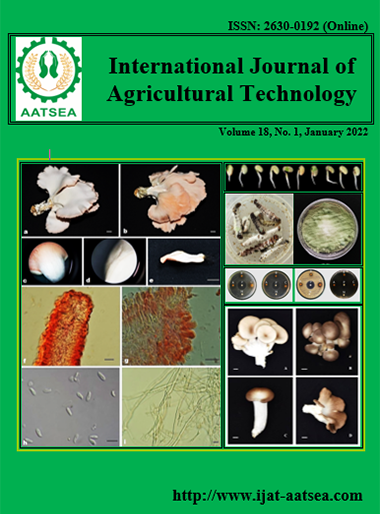Adoption of integrated pest management (IPM) technologies in Southern Philippines: constraints and motivations
Main Article Content
Abstract
Determining the factors that influence farmers’ adoption of IPM is critical to a successful sustainable pest management program. This study was conducted to determine the constraints and motivations in IPM adoption, involving 112 farmer participants of a Two-year IPM Training program (Years 2018 to 2019) in Southern Philippines. Of the 40 adopted technologies, ten were affected by training attendance. Most of the adopted technologies belonged to the bottom tier of the IPM Pyramid, which are the abiotic actions such as crop rotation, adopted by 42 to 85% of the participants. Training completers had higher level of adoption, from moderate to very high, than absentees whose adoption were mostly from low to moderate. Learners of IPM-based pesticide use also adopted IPM technology at a higher level than non-learners. Motivations, such as increases farm productivity and income, highly influenced training attendance. Constraints influenced the level of adoption. Lack of time and capital were common constraints among the various adopters, from low to very high adopter types. Low to high adopters also indicated laziness as a constraint in IPM adoption. Thus, these constraints and motivations are important factors to consider in designing IPM training programs to encourage attendance to training and, eventually, adoption of IPM technologies
Article Details

This work is licensed under a Creative Commons Attribution-NonCommercial-NoDerivatives 4.0 International License.
References
Alwang, J., Norton, G. and Larochelle, C. (2019). Obstacles to widespread diffusion of ipm in developing countries: lessons from the field. Journal of Integrated Pest Management 10. https://doi.org/10.1093/jipm/pmz008
Cepeda, N. J., Pashler, H., Vul, E., Wixted, J. T. and Rohrer, D. (2006). Distributed practice in verbal recall tasks: A review and quantitative synthesis. Psychological Bulletin, 132: 354-380. https://doi.org/10.1037/0033-2909.132.3.354.
DellaVigna, S. (2009). Psychology and economics: evidence from the field. Journal of Economic Literature, 47: 315-72. https://doi.org/10.1257/jel.47.2.315.
Heong, K. and Escalada, M. (1998). Changing rice farmers’ pest management practices through participation in a small-scale experiment. International Journal of Pest Management, 44: 191–197. https://doi.org/10.1080/096708798228095.
Jayasooriya, H. J. C. and Aheeyar, M. M. M. (2016). Adoption and factors affecting on adoption of integrated pest management among vegetable farmers in sri lanka. Procedia Food Science, 6: 208–212. https://doi.org/10.1016/j.profoo.2016.02.052
Jørs, E., Aramayo, A., Huici, O., Konradsen, F. and Gulis, G. (2017). Obstacles and opportunities for diffusion of integrated pest management strategies reported by bolivian small-scale farmers and agronomists. Environal Health Insights, 11:1178630217703390. https://doi.org/10.1177/1178630217703390.
Kirinya, J., Taylor, D., Kyamanywa, S., Karungi, J., Erbaugh, D. and Bonabana-Wabbi (2013). Adoption of integrated pest management (IPM) technologies in Uganda: review of economic studies. International Journal of Advanced Research, 1:401-420.
Larochelle, C., Alwang, J., Travis, E., Barrera, V. H. and Dominguez Andrade, J. M. (2019). Did you really get the message? Using text reminders to stimulate adoption of agricultural technologies. The Journal of Development Studies, 55:548-564.
https://doi.org/10.1080/00220388.2017.1393522.
Lukuyu, B., Place, F., Franzel, S. and Kiptot, E. (2012). Disseminating improved practices: are volunteer farmer trainers effective? The Journal of Agricultural Education and Extension, 18:525-540. https://doi.org/10.1080/1389224X.2012.707066
Mazur, R. (2014). Training and farmers’ organizations’ performance. Journal of Agricultural Education and Extension, 20:65-78.
NEDA XII. (2011). SOCCSKSARGEN regional development plan 2011-2016. National Economic and Development Authority Regional Development Council No. XII, Koronadal City, Philippines. 112 pp.
Oliver, P. F. and Dizon, J. T. (2016). Farmers’ participation in integrated pest management under the palayamanan program in camarines sur, philippines. Philippine Journal of Crop Science, 41:40-49.
Parsa, S., Morse, S., Bonifacio, A., Chancellor, T., Condori, B., Crespo-Perez, V., Hobbs, S., Kroschel, J., Ba, M., Rebaudo, F., Sherwood, S., Vanek, S., Faye, E., Herrera, M. and Dangles, O. (2014). Obstacles to integrated pest management adoption in developing countries. PNAS, 111:3889-3894.
Peterson, R. K. D., Higley, L. G. and Pedigo, L. P. (2018). Whatever happened to ipm? American Entomologist, 64:146-150. https://doi.org/10.1093/ae/tmy049.
Rahman, M. S. and Norton, G. W. (2019). Adoption and impacts of integrated pest management in bangladesh: evidence from smallholder bitter gourd growers. Horticulturae, 5. https://doi.org/doi:10.3390/horticulturae5020032.
Stenberg, J. A. (2017). A conceptual framework for integrated pest management. Trends in Plant Science, 22:759-769. https://doi.org/10.1016/j.tplants.2017.06.010.
Togbé, C. E., Haagsma, R., Aoudji, A. K. N. and Vodouhê, S. D. (2015). Effect of participatory research on farmers’ knowledge and practice of ipm: the case of cotton in benin. The Journal of Agricultural Education and Extension, 21:421-440. https://doi.org/10.1080/1389224X.2014.971829.


